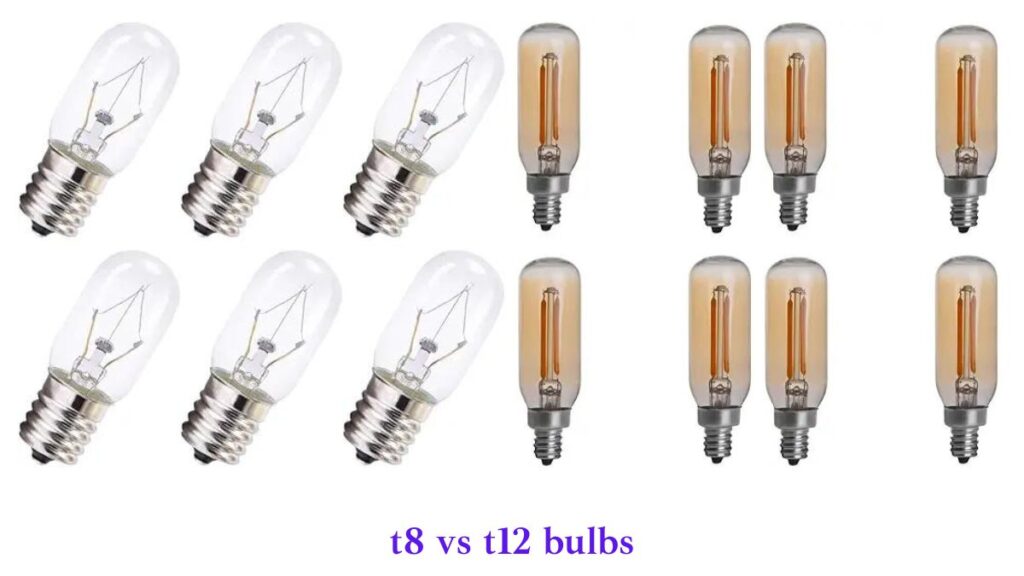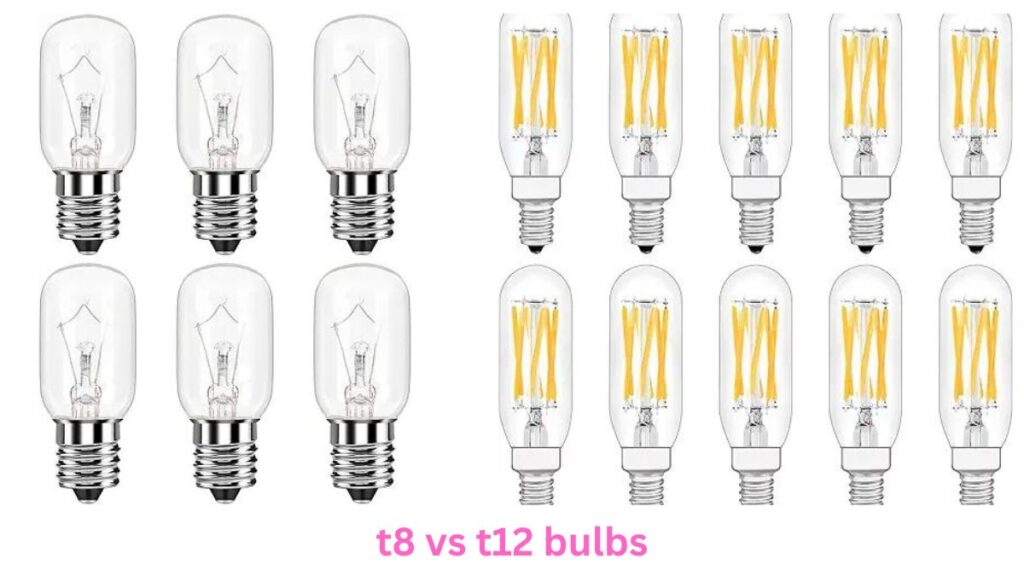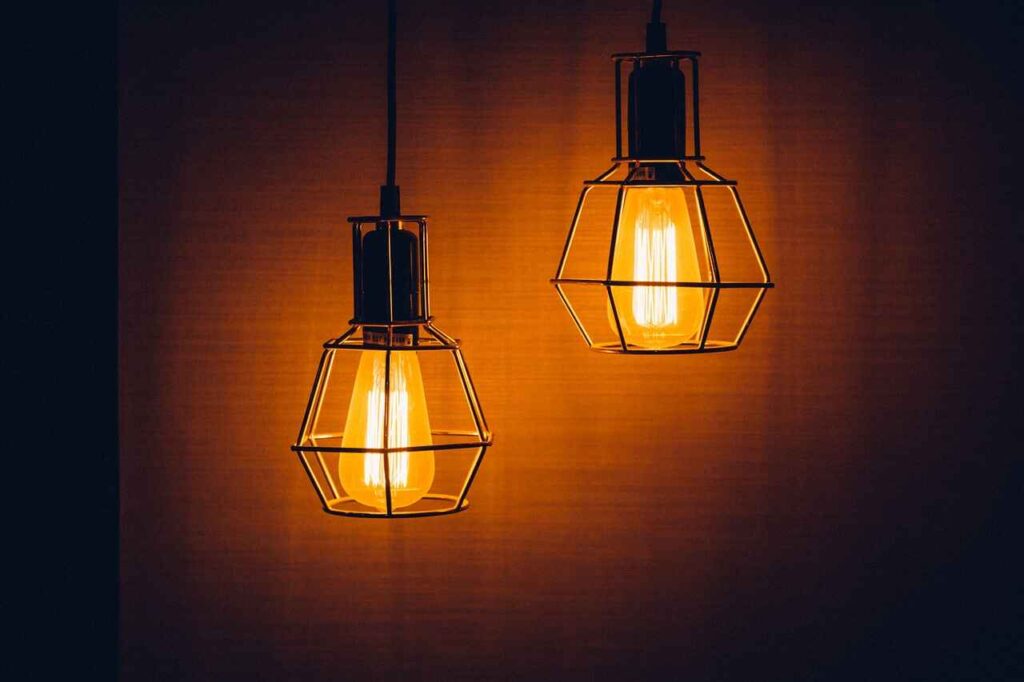Lighting technology has advanced significantly, yet the discussion about T8 vs T12 bulbs continues. Did you know that switching from T12 to T8 bulbs can cut energy consumption by up to 40%? This switch not only lowers electricity costs but also lessens environmental impact. In this article, we’ll explore the differences between T8 and T12 fluorescent bulbs to help you decide which option is best, whether you’re a homeowner or a business owner looking to save on costs. Let’s dive into this illuminating comparison and see which bulb shines brighter for your needs!

What Are T12 and T8 Bulbs?
Before we get into specifics, let’s cover the basics of what is the Difference between t8 and t12 bulbs.
- T12 Bulbs: T12 bulbs, one of the older types of fluorescent lights, have a diameter of 1.5 inches (or 38 mm). These bulbs have been widely used for decades, providing ample light in homes, businesses, and industrial settings. However, by today’s standards, they are less energy-efficient.
- T8 Bulbs: T8 bulbs, the more modern alternative, have a slimmer diameter of 1 inch (26 mm), making them more energy-efficient while still delivering high-quality light. The improved efficiency and environmental friendliness of T8 lights make them a preferred choice today.
What Does “T” Mean? The “T” in T12 and T8 stands for “tubular,” while the numbers refer to the diameter of each bulb in eighths of an inch. Thus, a T12 bulb is 12/8 inches (or 1.5 inches) in diameter, while a T8 bulb measures 8/8 inches (1 inch) in diameter.
The History of t12 vs t8 light bulbs
- Origins of T12 Bulbs: T12 fluorescent bulbs became popular in the mid-20th century for their ability to produce bright, efficient light for larger spaces. But as lighting technology advanced, the energy consumption of T12 bulbs proved high compared to newer models.
- Introduction of T8 Bulbs: Designed as a more energy-efficient option, T8 bulbs became widely adopted in both residential and commercial settings for their reduced energy consumption and improved light quality. The difference between T8 and T12 fluorescent bulbs led to regulatory changes, with T12 bulbs being phased out in many regions to encourage the use of T8 lighting.

Size and Physical Differences
One of the main differences between T12 and T8 is their physical size.
- Diameter: T12 bulbs have a diameter of 1.5 inches, while T8 bulbs are slimmer at just 1 inch. This difference affects T8 vs T12 bulb size compatibility with various fixtures.
- Length Options: Both T12 and T8 bulbs come in multiple lengths, commonly around 4 feet. Although the length may not vary much, the diameter can make T8 and T12 bulbs incompatible with each other without certain adjustments.
- Fixture Compatibility: Because of their different diameters, T8 bulbs may not fit in all fixtures made for T12 bulbs without modifications. When asking “Can I replace a T12 bulb with a T8?” or “Will T8 fit T12 fixtures?,” remember that an electronic ballast conversion may be required.
Energy Efficiency Comparison
Energy efficiency is a big reason for choosing T8 bulbs over T12 bulbs.
- Wattage: T12 bulbs generally require more power, typically around 40 watts, while T8 bulbs consume about 32 watts for similar brightness levels.
- Lumens Output: Despite the wattage difference, both T8 and T12 bulbs can produce comparable lumens (brightness). However, T8 bulbs achieve this more efficiently.
- Energy Consumption: T8 fluorescent bulbs consume less energy overall, saving money on electricity bills over time. Both households and businesses may see up to 40% in energy savings by switching to T8 bulbs.
Light Quality and Performance
When comparing the light quality of t12 vs t8, both have certain advantages.
- Color Rendering Index (CRI): T8 bulbs often have a higher CRI, meaning they display colors more accurately. This can be crucial for retail spaces or offices that need true color representation.
- Color Temperature: Both T12 and T8 bulbs come in a range of color temperatures, from warm to cool tones, though T8 bulbs typically offer a wider selection of modern lighting options.
- Flicker Rates: T12 bulbs tend to flicker, especially as they age, which can be uncomfortable and distracting in workspaces. T8 bulbs are engineered to reduce flicker, making them better for long-term use.
Lifespan and Durability
- Lifespan of T12 Bulbs: T12 bulbs generally last around 15,000 hours, but actual lifespan can vary depending on usage.
- Lifespan of T8 Bulbs: With an average lifespan between 20,000 to 30,000 hours, T8 lights are often the more cost-effective choice in the long run.
- Durability: Both T8 and T12 bulbs are made of glass, but T8 bulbs are typically more durable, with better resistance to damage.
Environmental Impact
- Mercury Content: Both T8 and T12 bulbs contain mercury, though T12 bulbs generally have a higher mercury content. Proper disposal is essential for both types due to this mercury presence.
- Energy Consumption: Since T8 bulbs use less energy, they have a smaller carbon footprint, making them a greener option.
- Disposal and Recycling: Proper disposal is required for both types, but T8 bulbs’ longer lifespan and lower energy consumption make them more environmentally friendly.

Applications and Best Uses
- T12 Bulbs: Despite being phased out, T12 bulbs can still be found in older fixtures and industrial settings where an upgrade hasn’t been made.
- T8 Bulbs: T8 bulbs are ideal for both residential and commercial use, especially in offices, schools, and stores where both energy efficiency and light quality are valued.
Making the Switch: T12 to T8 Conversion
If you’re considering an upgrade, here’s what to know about converting from T12 to T8 bulbs.
- Steps for Upgrading: Replacing T12 bulbs with T8 typically requires switching out the ballast as well. Most modern ballasts for T8 vs T12 are electronic and compatible with T8 bulbs, simplifying the process.
- Compatibility Issues: Older fixtures may not accommodate T8 bulbs directly, but upgrading the ballast makes conversion relatively simple and cost-effective.
- Rebates and Incentives: Many energy companies offer rebates for upgrading to energy-efficient lighting, such as T8 bulbs, helping offset conversion costs.
Conclusion: T12 Bulbs vs T8
In our detailed look at T8 vs T12 light bulbs, T8 bulbs are the superior choice when it comes to energy efficiency, lifespan, and performance. T12 bulbs have served well over the years, but T8 bulbs offer a more modern, eco-friendly solution. Whether you’re upgrading an existing setup or outfitting a new one, switching to T8 bulbs can lead to significant energy savings and a smaller environmental impact. Embrace the brighter future of lighting—T8 bulbs are lighting the way forward!
Hi, I’m Malik Suhail—an SEO expert, web designer, and passionate blogger with 2 years of experience. I specialize in crafting content that is not only informative but also tailored to meet the needs of my readers.
I write about diverse topics, always striving to simplify complex ideas and provide valuable insights that resonate with my audience. Whether it’s about SEO strategies, web design trends, or blogging tips, I am committed to delivering well-researched, practical, and easy-to-understand information.
My mission is to help readers navigate the digital world with confidence and clarity. I believe in adding value through authentic content that inspires action and delivers results.


